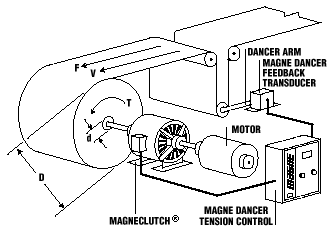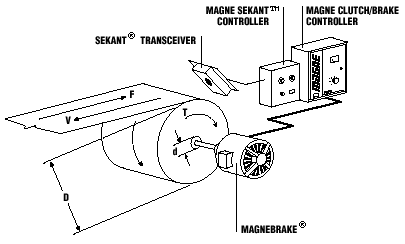Magneclutch - Torque Control Without Wear
MAGNE'S particle clutch is remarkably simple in construction and operation. The two moving parts - inner rotating member "A" and outer rotating member "B" - do not touch. They are cantilevered on the bearings.
The space between the inner and outer rotating members, "C", is filled with an extremely fine, dry magnetic powder. There is a second gap "D" between the outer rotating member and the stator frame. A stationary 90 volt (or 24 volt) DC coil "E" is built into the stator frame around this area. Current passing through the coil creates a magnetic field, causing the powder to form a link between the inner and outer rotating members and thereby transmit torque. Transmitted torque varies directly with the magnetic field strength through changes in current.
The clutch has no slip rings, friction plates or other friction bearing surfaces. Magnetic particle clutch characteristics do not change with years of usage. The powder does not wear out as friction clutches do.

The magnetic particle clutch's two rotating members are magnetically linked when the clutch is engaged. The members never touch.
When the magnetic particle clutch applies torque to the load, it starts without jerking. The load accelerates evenly, with no variations in acceleration rate. There is no bucking, grab or shock - not even a tremor from the clutch.
A friction clutch, however, uses two plates, of metal or other material. When engaged, these two friction plates slip (rub against each other) until they reach locked-in running speed.
With two surfaces rubbing at different speeds, precise control is difficult. The load doesn't accelerate evenly, because the plates tend to grab and release intermittently. This is known as the "stick-slip" phenomenon. As a result, the friction clutch accelerates and jerks.
The Magneclutch® provides complete control because magnetic particle action makes torque output directly proportional to coil current, independent of slip speed. The Magneclutch makes equipment more controlled and stable, longer lasting and easier to maintain.
Magnebrake - Stopping Control Without Wear
How? It's simple. The Magnebrake operates on the same principle as the Magneclutch except that one of the rotating members is held stationary resulting in braking torque instead of transmitted torque.

In Magnebrake's, the inner rotating member is permanently fixed, thereby establishing the braking characteristic.
The Magnebrake provides complete control. Complete brake control means managed and regulated braking action to exploit the brake's varied capabilities for superior power transmission. Since Magnebrake action does not involve friction, it provides many quality advantages.
